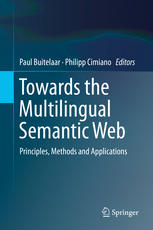

Most ebook files are in PDF format, so you can easily read them using various software such as Foxit Reader or directly on the Google Chrome browser.
Some ebook files are released by publishers in other formats such as .awz, .mobi, .epub, .fb2, etc. You may need to install specific software to read these formats on mobile/PC, such as Calibre.
Please read the tutorial at this link: https://ebookbell.com/faq
We offer FREE conversion to the popular formats you request; however, this may take some time. Therefore, right after payment, please email us, and we will try to provide the service as quickly as possible.
For some exceptional file formats or broken links (if any), please refrain from opening any disputes. Instead, email us first, and we will try to assist within a maximum of 6 hours.
EbookBell Team

4.7
96 reviewsTo date, the relation between multilingualism and the Semantic Web has not yet received enough attention in the research community. One major challenge for the Semantic Web community is to develop architectures, frameworks and systems that can help in overcoming national and language barriers, facilitating equal access to information produced in different cultures and languages. As such, this volume aims at documenting the state-of-the-art with regard to the vision of a Multilingual Semantic Web, in which semantic information will be accessible in and across multiple languages.
The Multilingual Semantic Web as envisioned in this volume will support the following functionalities: (1) responding to information needs in any language with regard to semantically structured data available on the Semantic Web and Linked Open Data (LOD) cloud, (2) verbalizing and accessing semantically structured data, ontologies or other conceptualizations in multiple languages, (3) harmonizing, integrating, aggregating, comparing and repurposing semantically structured data across languages and (4) aligning and reconciling ontologies or other conceptualizations across languages.
The volume is divided into three main sections: Principles, Methods and Applications. The section on “Principles” discusses models, architectures and methodologies that enrich the current Semantic Web architecture with features necessary to handle multiple languages. The section on “Methods” describes algorithms and approaches for solving key issues related to the construction of the Multilingual Semantic Web. The section on “Applications” describes the use of Multilingual Semantic Web based approaches in the context of several application domains.
This volume is essential reading for all academic and industrial researchers who want to embark on this new research field at the intersection of various research topics, including the Semantic Web, Linked Data, natural language processing, computational linguistics, terminology and information retrieval. It will also be of great interest to practitioners who are interested in re-examining their existing infrastructure and methodologies for handling multiple languages in Web applications or information retrieval systems.